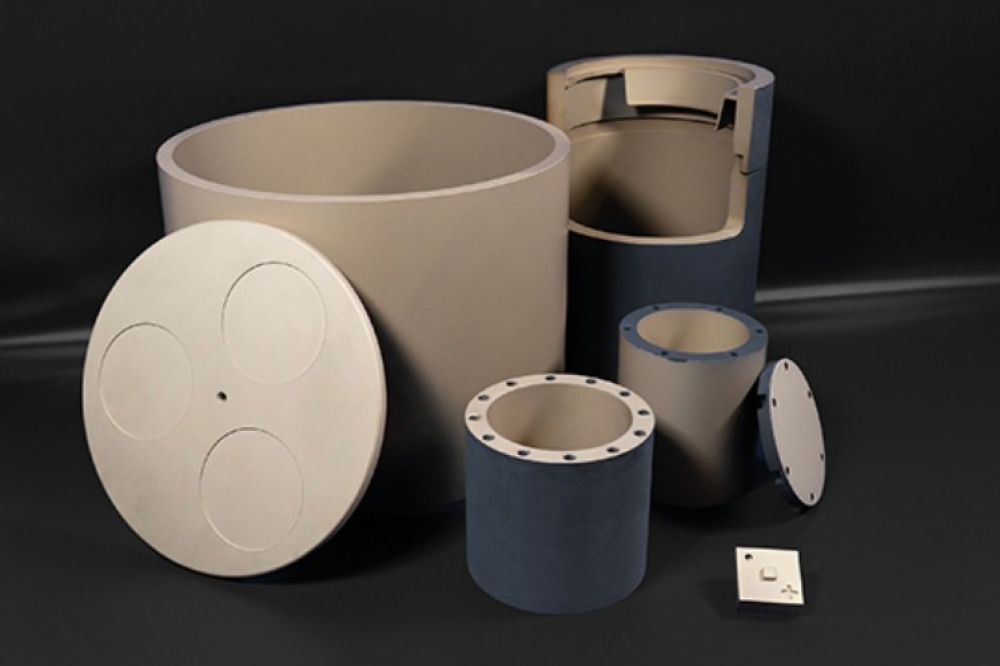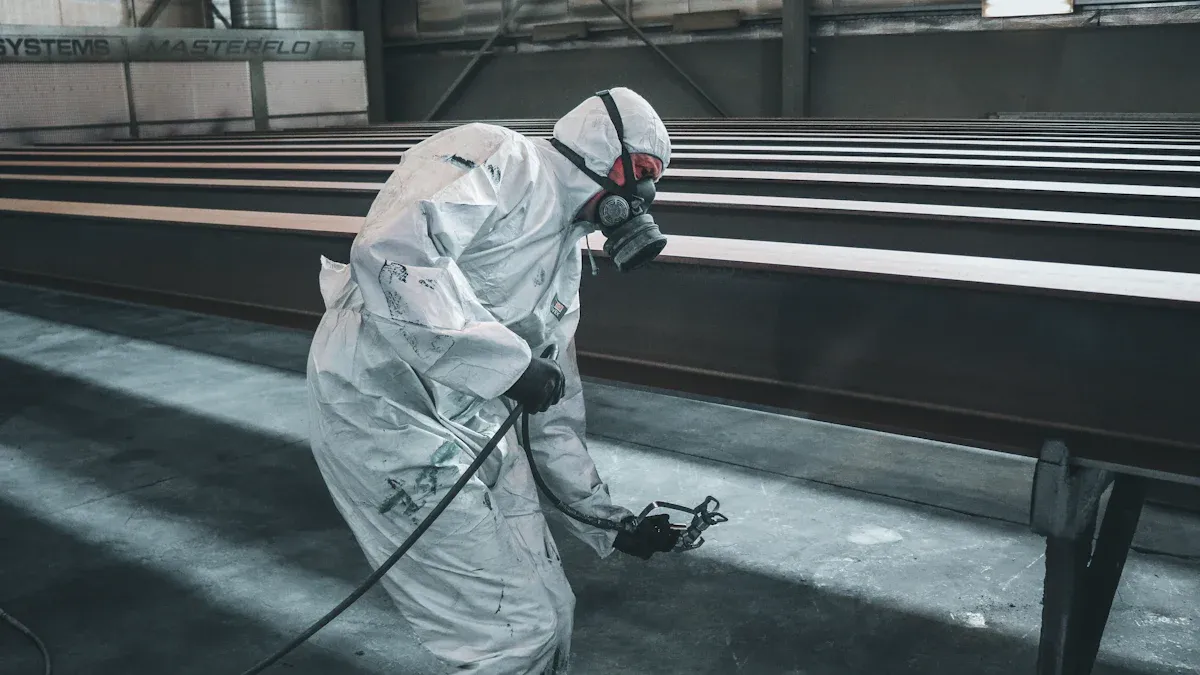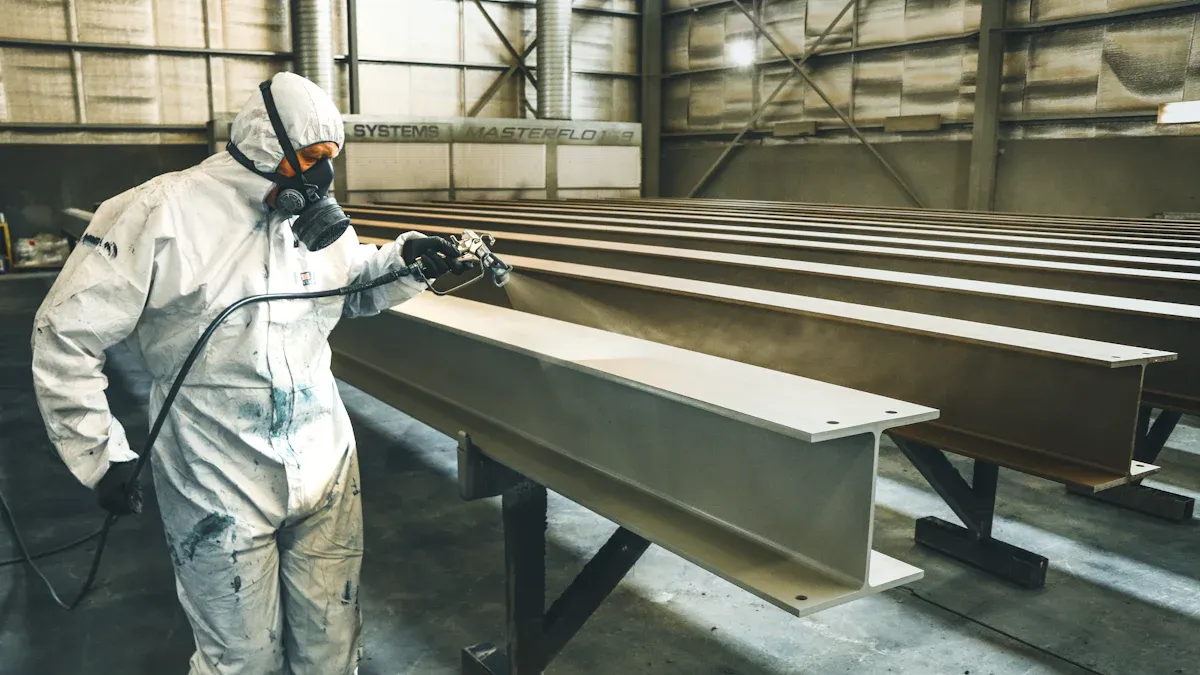
Silicon carbide (SiC) coating is essential for enhancing the performance and longevity of metal surfaces. Known for its exceptional durability, heat resistance, and corrosion protection, SiC coating is widely used across various industries. For instance, SiC coatings significantly extend the lifespan of graphite susceptors by allowing them to withstand high temperatures during deposition processes. This thermal stability minimizes contamination risks and ensures consistent heating profiles, which are crucial in semiconductor fabrication. SiC-coated components in the semiconductor industry are particularly valued for their ability to maintain precision under extreme conditions.
Industries such as aerospace, automotive, and manufacturing heavily depend on SiC-coated components. In the automotive sector, SiC thermal spray coating for automotive parts provides superior wear resistance and a longer service life, making it a reliable solution for demanding applications. Additionally, the cost of SiC coating services near me can vary based on specific requirements and applications, but the benefits often outweigh the investment.
To ensure its reliability, SiC coating lifespan and durability testing are conducted to confirm its performance in harsh environments. This testing highlights its versatility and resilience, solidifying its role as a preferred choice for critical applications across multiple industries.
Key Takeaways
- SiC coating makes metal stronger, heatproof, and rust-resistant. It is important for industries like airplanes and cars.
- Pick the best method for your project. Plasma spraying and CVD work well for big jobs, while brush coating is good for small tasks.
- Think about the metal type and how thick the coating should be. Cleaning the surface properly helps the coating stick better and last longer.
- Weather and environment affect how well the coating works. Match the method to your needs to make it last longer.
- Talk to experts to find the cheapest and easiest SiC coating method for your project.
Methods for Applying SiC Coating

Plasma Spraying
Plasma spraying offers a versatile method for applying SiC coating. This technique involves heating a material to a molten state using a plasma torch. The molten material then sprays onto the metal surface, forming a protective layer. Plasma spraying provides excellent control over the coating thickness. It also allows for uniform coverage, which enhances the durability of the SiC coating. Industries like aerospace and automotive often use this method due to its efficiency and effectiveness.
Chemical Vapor Deposition (CVD)
Chemical Vapor Deposition, or CVD, is another popular method for applying SiC coating. In this process, a chemical reaction occurs in a vapor phase, depositing a thin film on the metal surface. CVD offers high precision and uniformity, making it ideal for applications requiring exact specifications. This method is particularly useful in the semiconductor industry, where precision is crucial. CVD also provides excellent adhesion, ensuring the SiC coating remains intact under various conditions.
Chemical Vapor Reaction (CVR)
Chemical Vapor Reaction (CVR) is similar to CVD but involves a chemical reaction between the vapor and the substrate. This method creates a strong bond between the SiC coating and the metal surface. CVR is beneficial for applications that demand high thermal stability and corrosion resistance. It is often used in environments where the metal surfaces face extreme temperatures and harsh chemicals. The robust nature of the SiC coating applied through CVR makes it a preferred choice for critical applications.
Sol-Gel Coating
The sol-gel method provides a straightforward approach to applying SiC coating. This technique involves preparing a liquid solution, or “sol,” containing silicon carbide precursors. The sol is applied to the metal surface, where it undergoes a chemical transformation into a solid “gel.” Once the gel forms, the coated surface is heated to high temperatures to create a durable SiC layer.
This method offers several advantages. It allows for precise control over the coating’s thickness and composition. The sol-gel process also works well for complex geometries, making it suitable for intricate components. Industries such as manufacturing and electronics often use this method to enhance the performance of metal parts.
Tip: Proper preparation of the sol solution is critical for achieving a uniform and high-quality SiC coating.
Brush Coating
Brush coating is one of the simplest methods for applying SiC coating. It involves manually brushing a silicon carbide-based slurry onto the metal surface. This technique is ideal for small-scale applications or surfaces requiring localized protection.
Brush coating offers flexibility and ease of use. It does not require specialized equipment, making it a cost-effective option for certain projects. However, achieving uniform coverage can be challenging, especially on larger surfaces. This method is often used for repair work or in situations where precision is less critical.
Embedding Method
The embedding method involves incorporating SiC particles directly into the metal surface. This process typically uses mechanical or thermal techniques to embed the particles, creating a wear-resistant and heat-resistant layer.
This method excels in applications requiring high durability. It is commonly used in industries like automotive and aerospace, where components face extreme stress and temperatures. The embedding method ensures a strong bond between the SiC coating and the metal, enhancing its lifespan and performance.
Note: The embedding method may require advanced equipment and expertise, making it less suitable for small-scale applications.
Factors to Consider for SiC Coating
Type of Metal Surface
The type of metal surface plays a critical role in the success of SiC coating. Different metals have unique properties, such as thermal conductivity, hardness, and chemical reactivity. These factors influence how well the coating adheres and performs. For example, stainless steel and titanium often require specific surface preparation to ensure proper bonding. Surface roughness also affects adhesion. A smoother surface may need additional treatment to create a texture that allows the coating to stick effectively.
Tip: Conducting a surface compatibility test before applying the coating can help avoid adhesion issues.
Desired Coating Thickness
The thickness of the SiC coating determines its performance in various applications. A thicker coating provides better protection against wear and corrosion. However, it may also increase the weight of the component, which could be a concern in industries like aerospace. On the other hand, a thinner coating offers precision and is suitable for applications requiring minimal material addition. The desired thickness should align with the operational requirements of the coated part.
Manufacturers often use advanced techniques to control the thickness during the application process. This ensures the coating meets the specific needs of the project.
Environmental and Operational Conditions
Environmental and operational conditions significantly impact the choice of SiC coating. Factors such as temperature, humidity, and exposure to chemicals determine the coating’s durability. For instance, components exposed to high temperatures require a coating with excellent thermal stability. Similarly, parts used in corrosive environments need a coating that resists chemical degradation.
Understanding the operating environment helps in selecting the right application method and coating composition. This ensures the coated surface performs reliably under challenging conditions.
Cost and Scalability
The cost of applying SiC coating depends on several factors. These include the chosen application method, the size of the metal surface, and the desired coating thickness. Advanced techniques like Chemical Vapor Deposition (CVD) or Chemical Vapor Reaction (CVR) often require specialized equipment and skilled operators. This increases the overall expense. On the other hand, simpler methods like brush coating or the sol-gel process are more affordable but may not provide the same level of durability or precision.
Tip: For small-scale projects or repairs, consider cost-effective methods like brush coating. For industrial applications, investing in advanced techniques ensures better performance and longevity.
Scalability is another critical consideration. Some methods, such as plasma spraying, can handle large-scale production efficiently. These techniques are ideal for industries like automotive and aerospace, where high-volume coating is necessary. However, methods like embedding or sol-gel coating may be better suited for smaller batches or intricate components.
| Method | Cost | Scalability |
|---|---|---|
| Plasma Spraying | Moderate | High |
| Chemical Vapor Deposition (CVD) | High | Moderate to High |
| Brush Coating | Low | Low |
| Sol-Gel Coating | Low to Moderate | Moderate |
| Embedding Method | High | Low to Moderate |
Manufacturers must balance cost and scalability based on project requirements. High-volume production often justifies the expense of advanced methods. For smaller projects, simpler techniques may offer a more practical solution.
Note: Consulting with experts can help identify the most cost-effective and scalable method for specific applications. This ensures optimal results without exceeding budget constraints.
Challenges in Applying SiC Coating

Achieving Uniform Coating
Achieving a uniform coating remains one of the most significant challenges in applying SiC coating. Uneven application can lead to weak spots, reducing the coating’s effectiveness. Factors such as surface preparation, application technique, and equipment calibration play a critical role in ensuring uniformity. For instance, improper cleaning of the metal surface can cause the coating to adhere unevenly. Similarly, inconsistent spraying or brushing techniques may result in areas with varying thickness.
To address this issue, manufacturers often rely on advanced equipment and precise application methods. Automated systems, such as robotic sprayers, help maintain consistency across large surfaces. Regular equipment maintenance and operator training also improve the quality of the coating.
Tip: Conducting a test application on a sample surface can help identify potential issues before coating the final product.
Adhesion Issues
Adhesion problems occur when the SiC coating fails to bond properly with the metal surface. This can happen due to several reasons, including inadequate surface preparation, incompatible materials, or environmental factors during application. Poor adhesion reduces the coating’s durability and may cause it to peel or flake over time.
Surface preparation is crucial for improving adhesion. Techniques such as sandblasting or chemical etching create a rough texture, allowing the coating to grip the surface more effectively. Choosing the right application method also enhances bonding. For example, Chemical Vapor Deposition (CVD) provides excellent adhesion due to its ability to form a strong chemical bond with the substrate.
Note: Environmental conditions, such as humidity and temperature, should be controlled during the application process to avoid adhesion failures.
Equipment and Technical Expertise Requirements
Applying SiC coating often requires specialized equipment and skilled operators. Advanced methods like plasma spraying or CVD involve complex machinery that must be calibrated precisely. Without proper expertise, the coating process may result in defects, such as uneven thickness or poor adhesion.
Training operators and maintaining equipment are essential for achieving high-quality results. However, these requirements can increase the overall cost of the coating process. Small-scale projects or businesses with limited resources may find it challenging to invest in the necessary tools and expertise.
Tip: Partnering with experienced coating service providers can help overcome these challenges while ensuring reliable results.
Silicon carbide (SiC) coating offers diverse application methods, each suited to specific needs. Techniques like plasma spraying and CVD excel in industrial settings requiring precision and durability. Simpler methods, such as brush coating, work well for small-scale or localized projects.
Tip: For high-performance applications, methods like CVD or CVR provide superior adhesion and uniformity.
Selecting the right method depends on factors like cost, scalability, and operational conditions. Consulting with experts ensures the chosen technique aligns with project requirements, delivering optimal results.
Remember: A well-applied SiC coating enhances performance and extends the lifespan of metal surfaces.
FAQ
What is the best method for applying SiC coating?
The best method depends on the application. For industrial uses requiring precision, Chemical Vapor Deposition (CVD) works well. Brush coating suits small-scale projects. Plasma spraying offers a balance between cost and scalability.
Tip: Consult experts to match the method with your specific needs.
How long does SiC coating last?
SiC coating lasts for years under proper conditions. Its durability depends on factors like coating thickness, environmental exposure, and operational stress. Regular maintenance extends its lifespan.
Note: Testing the coating under real-world conditions ensures reliability.
Can SiC coating be applied to all metals?
SiC coating works on most metals, including stainless steel and titanium. However, surface preparation is crucial for proper adhesion. Some metals may require additional treatments to ensure compatibility.
Tip: Conduct a compatibility test before application.
Is SiC coating environmentally friendly?
SiC coating is considered environmentally friendly. It reduces wear and corrosion, minimizing the need for frequent replacements. This lowers waste and resource consumption over time.
Emoji Insight: 🌍 SiC coating supports sustainable practices in industries.
What industries benefit most from SiC coating?
Industries like aerospace, automotive, and manufacturing benefit greatly. SiC coating enhances durability, heat resistance, and corrosion protection, making it ideal for high-performance applications.
Example: Semiconductor manufacturing relies on SiC-coated components for precision and reliability.